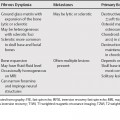41 Although squamous cell carcinoma (SCC) is the most commonly encountered neoplasm in the head and neck, lymphomas can arise in both nodal and extranodal sites in the head and neck and can be similar in appearance to squamous cell carcinomas (Table 41.1). The majority of head and neck lymphomas (and lymphomas in general) are non-Hodgkin’s lymphomas (NHL). Nodal involvement occurs with Hodgkin’s disease in the head and neck in 24% and with NHL in 33%. The head and neck is also the second most frequent site of extranodal involvement by NHL (11 to 33%). NHL of the neck arises in lymph nodes in 65% of cases and in extranodal sites in 25 to 30% of cases. Waldeyer’s ring is the most common extranodal location in the head and neck. Waldeyer’s ring is the primary site of lymphoma in 5 to 10% of patients, and this area accounts for at least one third of extranodal sites of involvement. The tonsil is the most commonly involved site, followed by the nasopharynx. Including Waldeyer’s ring, lymphoma can involve many of the sites that SCC involves, such as the sinonasal region and larynx, where it is usually supraglottic. Head and neck involvement by lymphoma is seen in the majority of patients with lymphoma associated with Sjögren syndrome. There may be additional findings associated with Sjögren syndrome such as lymphoepithelial lesions in the parotid glands.
Lymphoma
| Lymphoma | SCC | |
|---|---|---|
| Typical Appearance | Large bulky mass; occasionally infiltrative | May be mucosal lesion not evident on imaging to infiltrative enhancing lesion to bulky massa,b |





